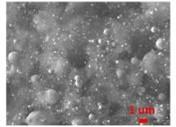Devices for water-splitting are an environmentally-friendly way of generating hydrogen used for energy storage applications. Electrocatalysts for hydrogen evolution reaction (HER) and oxygen evolution reaction (OER) play a critical role in efficiency and stability of these devices. The traditional methods used to produce catalytic electrodes is to deposit the catalysts onto a substrate, via solution casting or electrodeposition. The drawback of these methods is the morphology and the transport properties within the formed catalyst layer cannot be well controlled. There is a need for next generation fabrication methods for catalytic electrodes that can be finely tuned for optimum performance and not limited to just creating surface coatings on substrates.
LLNL researchers have developed novel catalytic electrodes for energy storage applications from inexpensive starting materials. The LLNL team are using a group of 3D printing inks that contain precursors of earth-abundant catalysts (e.g. Ni, Co and Fe compounds); the catalytic materials are imbedded into the ink matrix. To carefully control the properties such as surface area and those related to liquid electrolyte and gas transportation, the ink is used to 3D print complex scaffold structures. Afterwards, the 3D printed structures are post-processed to ensure uniform distribution of the catalysts throughout the scaffold of the electrode.
Image Caption: SEM image showing the morphology of a 3D printed porous carbon substrate with well distributed cobalt particles in cross section
(1) Uses earth-abundant catalysts made of non-noble metals (e.g., nickel, iron, cobalt)
(2) Tunable hierarchical pore size and distribution
(3) Enhanced surface area, and as a result, improved catalytic capability per area. The 3D structure increases accessibility of catalysts distributed throughout the carbon scaffold.
(4) LLNL inventors believe they can achieve < 300 mV overpotentials for OER and < 150 mV overpotentials for HER based on the 3D printed electrocatalysts tested using chronopotentiometry.
(5) In addition to hydrogen generation, this same technique can be used for other catalytic reactions such as carbon dioxide reduction, oxygen reduction/evolution.
- Photoelectrochemical water splitting to produce hydrogen
- CO2 capture and conversion
- Electrolysis
- Gas phase catalytic reaction processes
- 3D printing applications
Current stage of technology development: TRL 3
LLNL has patent(s) on this invention.
U.S. Patent No. 11,655,550 Engineering catalytical electrodes for applications in energy areas published 5/23/2023


